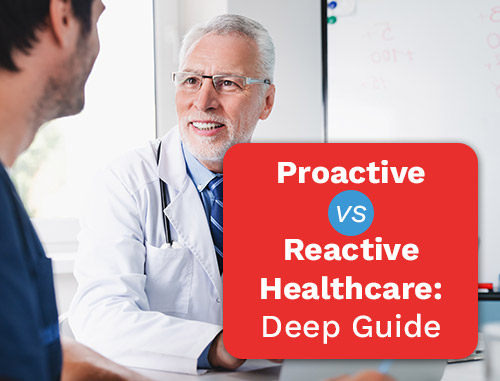Improve Your Healthcare Website ROI With These Strategies
Posted on
A strong online presence is essential for any healthcare practice to succeed in the modern, digitally-driven environment where people mostly rely on the internet to find healthcare providers. But having a website by itself is not enough; it also has to be optimized in order to draw in appropriate traffic and turn visitors into patients.
This is where healthcare SEO techniques come into play. They provide proven methods to increase the visibility of your website and, eventually, your ROI (return on investment). In this blog post, our experts will do their best to help you understand what you should do in order to keep up with the high pace of modern healthcare.
Why is SEO important for ROI improvement?
Healthcare SEO strategies play a crucial role in healthcare practices, enhancing ROI by ensuring high-ranking websites in search engine results pages (SERPs) when potential patients search for relevant keywords. Local SEO techniques, such as optimizing Google My Business listings, creating location-specific landing pages, and obtaining local citations, significantly improve visibility in local search results.

This hyperlocal targeting not only drives more foot traffic to your practice but also maximizes the conversion potential of local patients, thereby enhancing your overall ROI. Therefore, optimizing your website for local search intent is essential for attracting nearby patients.
User-friendly website for different devices
In the healthcare industry, SEO is essential since it offers a consistent user experience across platforms. A responsive website design guarantees that material is presented in the best possible way on PCs, mobile devices, and tablets, giving all users an enjoyable and easy-to-use experience. This improves accessibility and engagement, lowering entrance barriers for patients with disabilities and increasing the website’s usability for a wider audience. With Google switching to mobile-first indexing, it is even more important for healthcare practices to have a mobile-friendly website.
A website may not rank as highly in Google’s search results without optimization, which could result in a drop in traffic and visibility. Additionally, faster page loads are better for search engine rankings and the user experience, thanks to mobile optimization. We live in times when mobile phones are really close to fully replacing computers, so a healthcare practice can stay relevant and competitive by investing in mobile optimization and responsive design, setting it up for long-term success and expansion.

Local marketing and GMB
Healthcare SEO techniques are quite beneficial for medical facilities, especially those with a physical location. This includes building and refining your Google My Business (GMB) profile, getting positive feedback from satisfied clients, and optimizing your website for local keywords. Local SEO makes it easier for potential patients in your area to find and get in touch with your practice by promoting it in local search results.
High-quality content with keyword targeting
Success with healthcare SEO depends on producing high-quality, relevant content that speaks to the wants and worries of your target audience. You can boost your website’s exposure and draw in new patients by including relevant keywords and phrases in your content. Furthermore, adding new, educational content to your website on a regular basis tells search engines that your website is trustworthy and active, which raises your ranks even more.
Making previous content up-to-date
In addition to creating new content, it’s essential to regularly audit and update your existing content to ensure its relevance and accuracy. Irrelevant or outdated material might hurt your website’s search engine rankings and make it less enjoyable for users. You can maintain your website’s authority and trustworthiness in the eyes of search engines and users by making sure your material is fresh and useful.

Using video and images on your websites
Videos, images, and other visual content are excellent tools for SEO success. They can improve interaction, enhance search engine rankings, and efficiently communicate complicated information. Building up videos and pictures with alt text, descriptive filenames, and relevant keywords may help healthcare websites rank higher in search engine results pages (SERPs) and draw in more organic patients.
Visual information may be very helpful in the healthcare field for informing patients and outlining treatment options. Healthcare websites may position themselves as reliable information providers by offering useful instructional materials in an eye-catching style.
Utilizing social media and online reviews
Social media platforms offer great chances to interact with your audience, share educational materials, and advertise your medical services. You may improve your online reputation and draw in new patients to your office by being active on social media platforms that appeal to your target market and encouraging patients to provide positive feedback on platforms like Google, Facebook, and Instagram.

Staying updated with algorithm changes
It’s extremely important to stay up-to-date with search engine algorithm updates if you want to keep your website visible and competitive in search results. Refresh your knowledge of market trends and algorithm changes with credible sources, then modify your SEO strategies accordingly. Furthermore, think about working with a respectable healthcare digital marketing agency or consultant that can offer expert guidance and help in navigating the always-shifting field of healthcare SEO.
Remember, patient experience is your top priority
Healthcare SEO best practices are one of the most complex ways to improve the patient experience in the healthcare field. Practices may customize their website content and SEO efforts to deliver a smooth and meaningful experience by studying the search habits and informational demands of their patients. Businesses provide patients with the tools and resources they need to make informed decisions about their health, including informative videos, blogs, and social media posts.
Patient loyalty gets strengthened by a smooth online experience that is quick, easy to use, and accessible. Practices should think more about not only providing services but also about making patients feel calm and inspired in the process. ROI and medical benefit by putting the patient’s experience first. Thus, putting SEO tactics into practice is crucial for a healthcare practice to succeed.
Conclusion
Using efficient SEO tactics is crucial for promoting sustainable growth and optimizing your website’s return on investment in the fast-paced, demanding world of healthcare marketing. Prioritizing user experience, creating excellent content, and utilizing modern healthcare local SEO strategies will help you improve your web presence, draw in more patients, and eventually run a successful medical practice in the long run.
Recall that SEO requires constant modification and improvement rather than being a one-time endeavor. Through constant assessment and modification of your tactics to correspond with the changing requirements of your target audience and the most recent developments in search engine optimization, you can set up your medical practice for long-term growth and profit in the age of the digital revolution.

 Reaching The Right Audience Through Target Marketi..
Reaching The Right Audience Through Target Marketi.. Key Elements Affecting Your Website’s Performanc..
Key Elements Affecting Your Website’s Performanc.. Proactive vs. Reactive Healthcare: Deep Guide
Proactive vs. Reactive Healthcare: Deep Guide